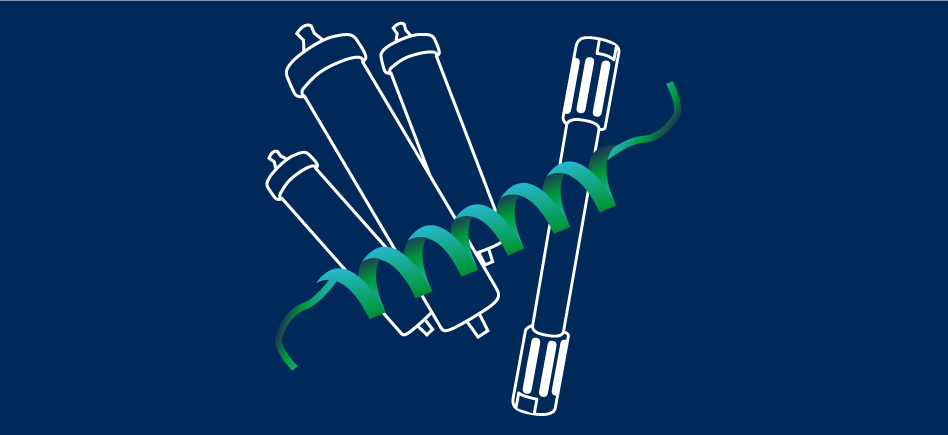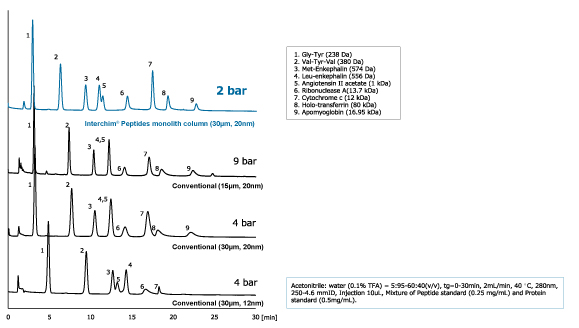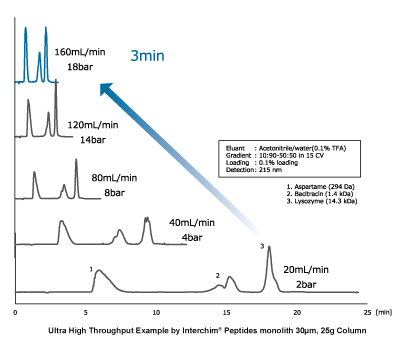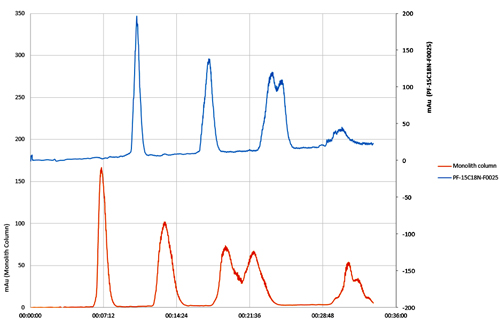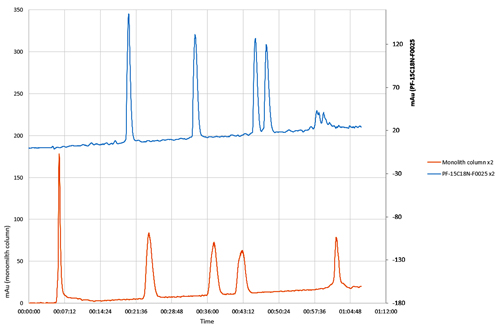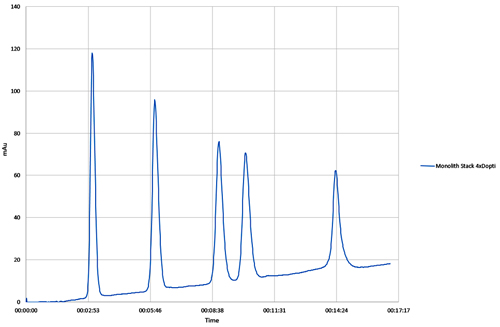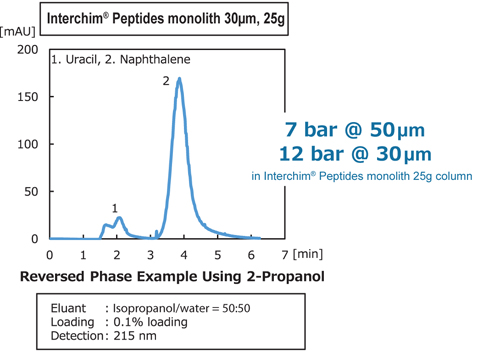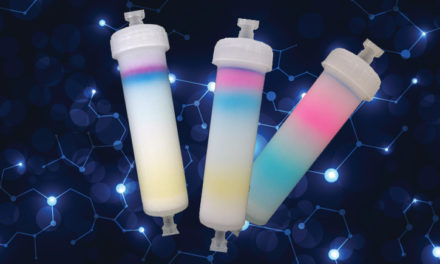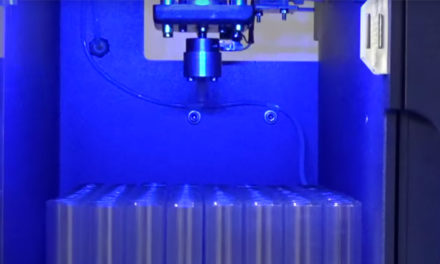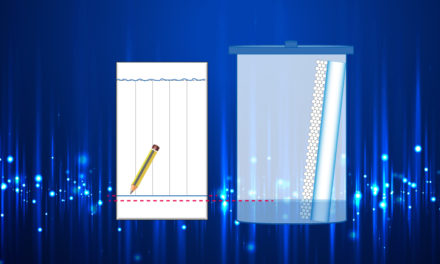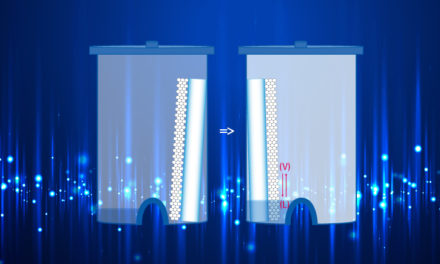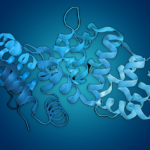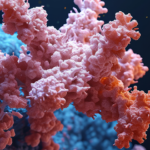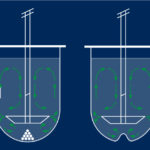The purification of compounds is always a compromise between desired purity, the sample load and the duration of methods. To improve efficiency in obtaining pure compounds, chemists must find the best balance between purity, duration of the method, and environmental considerations. This delicate balance is often necessary for both raw products and final purification.
Due to their particular structure, the puriFLash® Monolith columns provide a great help for all the points on which a balance must be implemented.
What is a puriFlash® monolith column?
Interchim® Peptides monolith column is a pre-packed column with the novel silica gel for reversed-phase liquid chromatography that will permit high-speed processing only with a medium to low back pressure.
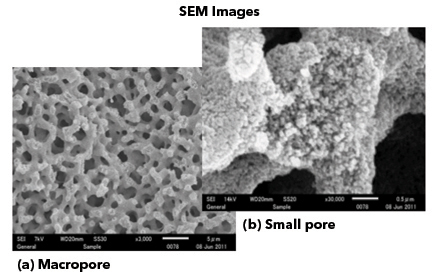 How puriFlash®monolith columns can provide best results?
How puriFlash®monolith columns can provide best results?
In the pores of this monolith, there are two structures (Macro and micro pores), which allow a faster and deeper diffusion of the solvent inside the particles. That conduces to a more effective purification, especially of macromolecules such as peptides, with an extremely low pressure.
Particle of 30µm which provide equivalent result of 15µm and less pressure
When used with the optimum flow rates, these 30μm phase-fill columns will give you at least 15μm phase results, as shown in the comparison below.
Ultra-High throughput
Increase the flow-rate of purifications to the limit pressure of your columns and significantly reduce the time of purifications.
As these columns generate less pressure, it becomes possible to use flow rates higher than the optimum flow of your columns, without losing the separation’s quality for better productivity. This example shows that it is possible to use 10x the optimum flow without losing the quality of separation. This product therefore allows better productivity.
This advantage can even be used when a purification requires to stack columns for difficult purifications. Then, it will be possible not only to stack columns, but also to work at a higher flow rate than the optimum, which is not possible with conventional silica.
Example :
Sample:
1- GLY-TYR 238
2- VAL-TYR-VAL 380
3- Met-Enkephalin 574
4- Angiotensin 1 000
5- Cytochrome c from bovine heart 11749
Method :
Solvant A : Water + 0.1%TFA
Solvent B : ACN + 0.1%TFA
Gradient : 5 to 40% d’ACN in 33 :45
Débit : 15 mL/min
Pression : 4 bar (monolith)
7 bar (PF-15C18N-F0025)
For this application, the two columns give a similar result.
The compounds 3 and 4 are co-eluted.
Gradient : 5 to 40% d’ACN in 66 :30
Débit : 15 mL/min
Pression : 4 bar (monolith)
13 bar (PF-15C18N-F0025)
With the stack of two columns we get to separate compounds 3 and 4 but the run time is then doubled exceeding the hour!
Gradient : 5 to 40% d’ACN in 16 :30
Débit : 60 mL/min
Pression : 17 bar (Monolith)
Impossible avec PF-15C18N-F0025
When increasing the flow-rate, even slightly, the column PF-15C18N-F0025 generates too much pressure, so it is not possible to significantly reduce the run time.
On the contrary, the monolith column makes it possible here to increase the flow rate to 60mL / min (4 times the optimum flow rate) and makes the purification time to 16min.
The time saving is important.
Less toxicity
Thanks to the pressure, it’s possible to use viscous solvent as isopropanol. Free from toxics solvents as acetonitrile and methanol.
In this application, eluent solvent is IPA/Water, 1:1, we see that the generated pressure is under max pressure of F0025 column.
Enhanced Performance with Any System!
Even in the reverse phase purification, the pressure of Interchim® puriFlash® monolith column is as low as 2 bar or less, at a standard flow rate and can be adapted to any low / medium pressure machine like puriFlash® machines. Moreover, it is quite easy to improve separation performance by stacking 2 or more columns.
Why choose puriFlash®monolith columns?
As the different results show, the use of puriFlash® monolith columns will help you to:
– save up to 80% of run-time on your purifications and increase your productivity.
– use columns with a particle size of 30 μm and obtain results at least equivalent
to 15 μm columns.
– get rid of toxic solvents such as acetonitrile and methanol, and even use solvents
generating high back pressure such as isopropanol.
– use small particle size columns on low pressure systems for better performance.
Learn more:
Find the complete list of columns here.

